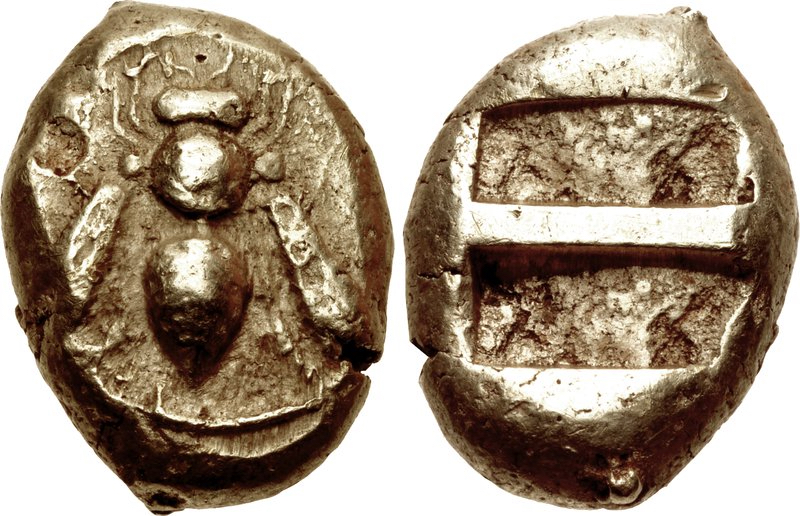
IONIA, Ephesos. Circa 550 BC. EL Hemistater (13mm, 6.86 g). Bee / Two parallel narrow rectangular incuses (struck from a single punch). Triton X, lot 289; otherwise unpublished. Good VF. Extremely rare, one of only two published. From the collection of Dr. Lawrence A. Adams, purchased from Superior Stamp & Coin, April 1993. Ex Superior (12 December 1992), lot 2125. The early coinage of Ephesos was most recently studied by S. Karwiese (Die Münzprägung von Ephesos [Vienna, 1995]), though his conclusions have been slightly modified by K. Konuk (see, e.g., SNG Kayhan). This interesting hemistater issue represents a series unknown to Karwiese. The first coinage attributable to Ephesos is the electrum series struck under the enigmatic Phanes, circa 625-600 BC, comprising a host of denominations from stater to 1/96 stater. Phanes’ series was followed by electrum and silver coins that were the first to depict the Ephesian bee, circa 600-550 BC (Karwiese Series II.2). The bee on these electrum coins has a very primitive appearance, and the punches on the reverse closely resemble those used for the Phanes coinage. The subsequent group, Karwiese’s Series III, circa 550-500 BC, again with both electrum and silver issues, featured a more realistic bee on the obverse and a simple rough square incuse on the reverse. The present hemistater has a bee that is consistent with the form found on Series III, while the punches on the reverse are distinctly different from those of the preceding Series II.2. As such, this issue appears to belong after the earlier bee electrum, while the form of the punches and the fabric of the coin suggest that it is earlier than those of Series III. It is also possible that this type is not from Ephesos, but from another mint in Asia Minor, considering the unusual incuse form (cf. Rosen 248–9). This incuse form is also common on early electrum issues from Samos (cf. Wiedauer 196), as well as archaic silver staters from mints in the vicinity of Caria (cf. SNG von Aulock 2337 and 2744, and Asyut 694-702). One aspect of the present issue, though, is significantly different from all of these non-Ephesian coins: the reverse is composed of two punches from a single rectangular die. Moreover, this peculiarity is mimicked on a silver issue, also featuring a similarly-styled bee on the obverse, that came to light recently: CNG 75, lot 360 and CNG 96, lot 429. This connection provides the strongest evidence for the placement of these coins at Ephesos, as the details of the bee on the CNG 75 coin are identical to those on the sole electrum hekte of Karwiese’s Series III. Thus, this issue of electrum hemistaters and silver drachms appear to form a new issue at Ephesos, circa 550 BC.
Author: IONIA, Ephesos | Date: Circa 550 BC

